Djed › Djoser › Pizarro & the Fall of the Inca Empire » Origins and History
Articles and Definitions › Contents
- Djed › Origins
- Djoser › Who Was
- Pizarro & the Fall of the Inca Empire › Who Was
Ancient civilizations › Historical places, and their characters
Djed › Origins
Definition and Origins

The djed is an ancient Egyptian symbol for stability which features prominently in Egyptian art and architecture throughout the country's history. `Stability' should be understood to mean not only a firm footing but immutability and permanance. The symbol is a column with a broad base which narrows as it rises to a capital and is crossed by four parallel lines. The column and the lines are sometimes brightly painted and other times monochrome. The djed first appears in the Predynastic Period in Egypt (c. 6000-3150 BCE) and continues through the Ptolemaic Dynasty (323-30 BCE), the last dynasty to rule Egyptbefore it became a province of the Roman Empire.
The djed is often overlooked in Egyptian art, and especially in architecture, simply because it is so ubiquitous; the djed is featured on pillars, tomb walls, architraves (the main beam which rests on pillars), palace walls, sheets of painted papyrus, and especially sarcophagi. Once one is aware of the djed and its importance to ancient Egyptian culture it is impossible to miss. It is a potent symbol associated with the god Osiris and his return from the dead. The symbol has been interpreted to represent different objects such as the god Osiris' backbone, the tamarisk tree which enclosed the god, four pillars rising one behind another, and a fertility pole raised at festivals. `Stability', however, seems to have been its prime meaning and the one which the ancient Egyptians attached the greatest importance to.
MEANING & ORIGINS
The precise origin of the djed is unknown but it was associated with the god Ptah, an early creator god in the Predynastic Period whose attributes were later assumed by the deities Atum and Osiris. According to historian Clare Gibson, the djed was an early phonogram which could also act as a pictogram or ideogram. A phonogram is a symbol representing a sound and a pictogram a symbol for a specific word or phrase while an ideogram is a symbol of a thing itself without reference to words or sounds (such as numerals where one recognizes the symbol 10 as representing a certain quantity). The djed symbolized the spoken word-concept for stability, was the written word for stability, and stood for the concept itself.
THE DJED SYMBOLIZED THE SPOKEN WORD-CONCEPT FOR STABILITY, WAS THE WRITTEN WORD FOR STABILITY, AND STOOD FOR THE CONCEPT ITSELF.
In the Predynastic Period it may have originally been a representation of a fertility pole upon which sheaves of grain were suspended at festivals. This pole may have been a feature of early fertility rituals which eventually came to be associated with the god who made the land fertile. The god Ptah carried a sceptre which combined the djed and the Ankh (symbol of life) and is referenced as "The Noble Djed" in ancient inscriptions. The Djed Pillar Festival was held annually at which an actual djed pillar was built and raised by the local priesthood on the first day of the harvest season. Raising the pillar may have originally symbolized the grains rising from the earth but, in time, came to represent the god Osiris returning from the dead.
With the rise of the cult of Osiris, the djed came to be firmly associated with him and, especially, with the tree of Byblos which enclosed him and the pillar made from that tree. The djed also symbolized the backbone of Osiris in that, just as Osiris rose from the dead, the deceased would rise from their body after death. In the same way that the human backbone allowed one to sit up and stand and walk, the spiritual image of Osiris' backbone would encourage the soul to rise up from the body and move toward the afterlife. The myth of Osiris was one of the most popular in ancient Egypt, especially in the period of the New Kingdom (1570-1069 BCE). The story details the death of the god, his ressurection by his wife Isis, and descent to the underworld to reign as Lord of the Dead.
THE MYTH OF OSIRIS
In the beginning of time, shortly after creation, the gods Osiris, Isis, Set, Nepthys, and Horus were born of the union between Geb (earth) and Nut (sky). Osiris, as the eldest, was given reign of the earth and took his sister Isis as his wife and queen. Set grew jealous of Osiris' success and trapped him in a coffin which he then threw into the Nile River. The coffin floated to the Phoenician city of Byblos where it became lodged in a tamarisk tree by the shore. The tree quickly grew around and enclosed the coffin within it. The king and queen of Byblos noticed the tree and that it gave forth a sweet scent and so had it cut down and brought to their palace to decorate the court as a central pillar.

Ankh, Djed & Was
Isis, in the meantime, had gone searching for her missing husband and finally arrived at the court of Byblos. Disguised as an older woman, she ingratiated herself to the royal family by teaching the handmaidens how to plait their hair and became nursemaid to the young princes. Isis was particularly fond of the younger child, Dictys, and tried to make him immortal by burning away his mortal part in a flame. When the queen found her doing this one night she became upset and Isis threw off her disguise to reveal herself as a goddess. The royal couple begged her mercy for their affrontery and promised her anything she wanted; Isis claimed the tree which held her husband.
She freed Osiris' body from the tree and brought him back to Egypt to revive him but, while she was out gathering the necessary herbs, Set found the body, cut it into pieces, and scattered it across the land. When Isis found her husband had been dismembered she instantly set about collecting his remains with the help of her sister Nepthys. They found all his body parts, except for his penis which had been eaten by a fish, and he was brought back to life. Isis transformed herself into a kite and summoned the seed from Osiris' body by flying around him, drawing the seed into herself and becoming pregnant with a son, Horus. Osiris, since he was not complete, could no longer rule the living and descended to the underworld as Lord of the Dead. Horus grew to maturity and then challenged Set for rule, defeating him and restoring order to the land. The myth illustrated the importance of ma'at (harmony) and the triumph of order over chaos.
THE DJED & OSIRIS
This best known version of the myth (which comes from the Greek writer Plutarch, 45-120 CE) places the tamarisk tree at Byblos but other versions say the tree was by the shores of the city of Djedu in Syria. This has led some scholars to assert that Osiris was originally a Syrian fertility god who was introduced to Egypt through trade. According to this theory, the djed was their cult symbol which was based on the practice of decorating a pillar to resemble a tree and draping it with icons representing fertility and abundant harvest. This theory has some merit, primarily due to the name of the Syrian city lending itself to the symbol, but falters in claiming validity based on the scarcity of trees in Egypt and their abundance in Syria.
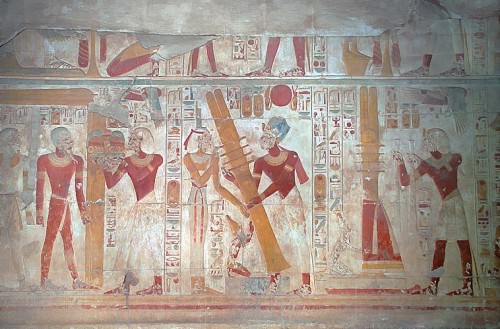
Djed Pillars, Hall of Osiris, Abydos
Whatever abundance of forestation Syria may or may not have enjoyed, trees featured prominently in Egyptian literature as special blessings from the gods and even their homes. Osiris may have originally been a Syrian deity but one cannot base this claim on a scarcity of trees in Egypt. Osiris' name first appears in the Fifth Dynasty of Egypt (2498-2345 BCE) even though images of him pre-date this period and his origins are obscure. By the time of the New Kingdom, however, he was among the most popular and important gods of Egypt and the djed symbol was linked to his story. Scholar Geraldine Pinch comments on this, writing :
By the New Kingdom, the djed was closely associated with the mythology of Osiris. The taboo subject of the murder of Osiris could be alluded to by saying that Set had "laid the djed on its side". Scenes in temples or royal tombs show the god Horus (or the king playing the role of Horus) raising the djed column to help his father Osiris to rise from the dead (128).
The Osiris myth, with its emphasis on resurrection, immortality, and order from chaos, expressed some of the most highly valued concepts in Egyptian culture and Osiris became one of the most often invoked gods. His wife, Isis, rose to even greater prominence to eventually become the only deity in Egypt worshipped by everyone regardless of their location or duty to other gods. Isis was associated with the symbol of the tiet (also tjet, the `knot') representing fertility and was often paired with the djed, especially on Egyptian coffins. Scholar Clare Gibson comments on this pairing, writing:
It is particularly significant that the djed and the tiet are given such prominence, for these symbols respectively represented Osiris and Isis, or the masculine and feminine principles (and it is probably no coincidence that one is phallic and the other, uterine in shape), and together thus the innate potential to bring new life into being (159).
Osiris, though no longer ruler of the world, had given life to the people and, through his son, brought harmony to the land. In his role as Lord of the Dead, Osiris was the just judge who presided over the fate of the soul in the Hall of Truth. It is hardly surprising, then, that his symbol should be found on the walls of tombs, in the Pyramid Texts, and on coffins. The Egyptians believed that their earthly journey was only one aspect of an eternal voyage and death was simply another realm to be traveled. The djed symbol, like the Pyramid Texts themselves, would have been inscribed where the soul could see it in order to help free the eternal aspect of the individual from the physical body after death.
THE DJED IN ART & ARCHITECTURE
As noted above, there are so many instances of the djed featured in the art works and building projects of the Egyptians it is impossible to overlook the symbol once one is aware of it. A notable use of the Djed in the Early Dynastic Period (c.3150-2613) is the temple complex of the Step Pyramid of Djoser at Saqqara. The pillars of the interior of Temple T, in the Heb Sed Court, are decorated with djed symbols. The djed is also represented in a very interesting fashion at the South Tomb of the complex where a series of cobras rise in stone from the facade. The spaces in between these cobras are djed-shaped.
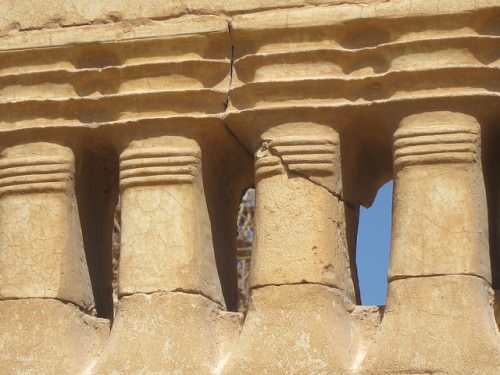
Djed pillars
Raising the djed pillar was an important part of the festival known as the Heb Sed which was observed to restore power to the king. Geraldine Pinch notes how, at this festival, "the raising of the djed was preceeded by a mock combat between people representing the opposing forces of order and chaos" (128). Once order had been restored, the djed pillar was raised as a symbol of triumph and stability. The king would be renewed through his association with Osiris who returned from death to life.Temple T's djed pillars and the other djed symbols in the Saqqara complex invoked not only Osiris and his resurrection but represented stability in that they were carefully placed to look like pillars holding up the sky. There are many different sites throughout Egypt where one sees djed symbols repeated across the lintels and architrives of buldings and, if one does not recognize the djed, these seem to be simple ornamentation; if one does, however, the djed symbols are clearly pillars supporting the canopy of the sky above.
In the Old Kingdom the djed is featured prominently on tombs as it continues to be in the New Kingdom. The Book of the Dead is illustrated with so many djed symbols that they sometimes blend into a kind of wallpaper behind the images of the soul ascending and the attendant gods. The New Kingdom tomb of the scribe Ani, dated to c. 1250 BCE, is inscribed with a page from the Book of the Dead customized to speak directly to Ani's soul. As with all such tomb inscriptions, the purpose was to direct the soul toward the afterlife and assist in leaving the body and the things of the earth behind. Ani's tomb shows his soul leaving his wife, his life, and his body behind to travel toward Osiris in the Hall of Truth. Gibson comments on this, writing:
The vignettes that illustrate the passages of text reproduced here are all imbued with profound significance regarding what the ancient Egyptians devoutly hoped would occur after their death, with the scenarios shown invoking the aid and protection of the gods Osiris, Anubis, and Nepthys, and giving prominent positions to such amuletic symbols as the djed pillar and the lotus and papyrus plants (173).
The djed pillar not only symbolized stability in life and after death but also the enduring presence of the gods in one's life. The symbol assured the ancient Egyptians that the gods were with them every step of their journey through their earthly travels and would continue with them after death. The djed symbol promised human beings that, like Osiris, they would rise from death to life and continue on to live eternally in the Field of Reeds. The Egyptian afterlife was a mirror-image of one's life on earth but eternally blissful without loss, disappointment, or death. The immutability of the soul and the promise of this eternal life was represented by the djed. The symbol appears so regularly throughout Egypt's history because it reminded the people of the true nature of life, that death was not the end, and that the gods were always near.
Djoser › Who Was
Definition and Origins
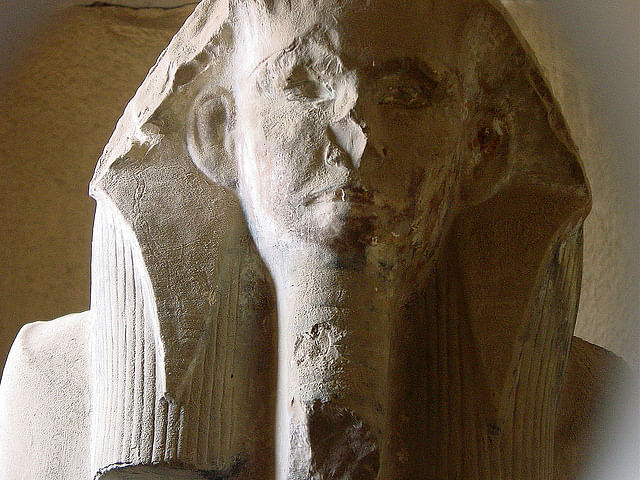
Djoser (also known as Netjerikhet, Tosorthos, and Sesorthos, c. 2670 BCE) was the first king of the Third Dynasty of Egypt, reigning for over twenty years. Some sources indicate a king named Sanakht as the first ruler of the Third Dynasty but this claim is challenged as Sanakht's name is only known from two reliefs, the Abydos king list, and the Turin papyrus, not from archaeological evidence. Early archaeologists identified Sanakht's tomb as mastaba K2 at Beit Khallaf based on the two reliefs mentioned above, which were found there; but this identification has been challenged and largely discredited. Manetho's chronology, routinely used to date the reigns of the kings of Egypt, is also unclear on who he was or when he ruled. Djoser's reign, following Khasekhemwy, is far more certain than the vague suggestions of a king named Sanakht and so he is now accepted as the first king of the Third Dynasty. Djoser is best known for his Step Pyramid, the first pyramid built in Egypt, although he initiated many other building projects; so many, in fact, that scholars have suggested a reign of almost thirty years to account for the number of tombs, temples, and monuments he commissioned.
REIGN
Very little is known of Djoser's youth or family life. His name Netjerikhet means "divine of body" and 'Djoser' is derived from the Djed symbol of stability. He succeeded his father, Khasekhemwy, the last king of the Second Dynasty, and his mother was the queen Nimaathap. His wife was Hetephernebti who was probably his half-sister. Although it was common for the pharaoh to have a queen and lesser wives, Djoser took no other women besides Hetephernebti.
ONCE DJOSER ASSUMED THE THRONE, HE ALMOST INSTANTLY BEGAN COMMISSIONING HIS BUILDING PROJECTS.
Once he assumed the throne, he almost instantly began commissioning his building projects. Historian Margaret Bunson writes that Djoser "ruled during an age witnessing advances in civilization on the Nile such as the construction of architectural monuments, agricultural developments, trade, and the rise of the cities " (66). Although cities had begun to grow during the First Dynasty, under Djoser's reign they became more numerous and the architecture more ornate. Djoser's pyramid complex alone is the best example of the great advance in architectural design at the beginning of the Third Dynasty. Ornamentation was taken to a much higher level and symbols used to remind people of the blessings of the gods and the harmony of the land. The Djed symbol which, besides representing stability, is associated with the god Osiris, was used in the pillars in Temple T of Djoser's Saqqara complex and appears on his other monuments as well.
The stability of the country under Djoser was due in part to his success in securing his borders and then extending them.Expansion of the realm into the region of Sinai was accomplished through military expeditions. He defeated the Libyans in battle and annexed part of their lands. The position of the king was linked to military ability and victories were a sign of the gods' favor. The armies of Djoser, therefore, brought honor to his name and to the country but he became legendary, without these campaigns and long before his Step Pyramid was built, for another reason: the re-building of the Temple of Khnum which ended a famine.
THE FAMINE STELE
The Famine Stele is an inscription from the Ptolemaic Dynasty (332-30 BCE), long after Djoser's rule, which tells the story of how the king saved his country. A famine broke out in Egypt which lasted for seven years. No one knew how to resolve the problem and none of Djoser's consultants seemed to be of any use. Djoser had a dream in which the god Khnum, the god of the source of the Nile River, came to him and complained that his temple on the island of Elephantine (near modern-day Aswan) was in disrepair and people had lost their respect for the god who gave them life through the river.
Djoser consulted with his vizier Imhotep and with one of his governors, Medir, and they suggested he sail to the island of Elephantine to pay his respects to Khnum and see about the temple. Djoser did so and, finding the temple in the poor condition his dream had foretold, erected a new one in its place. Once the new temple was completed, the famine ended and Djoser was hailed as the hero of his people.
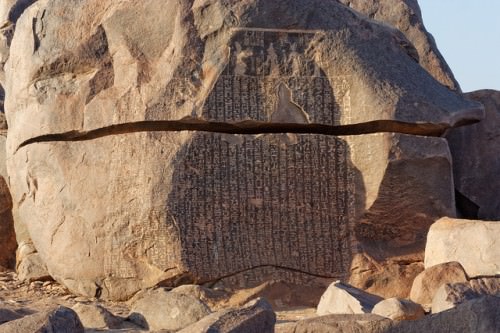
Famine Stele
The temple built by Djoser, and the surrounding courtyard and outer buildings, may still be seen in the modern day, although the temple went through renovations during later dynasties. These modern-day ruins date from Djoser's reign and so the Famine Stele has been accepted by some as history and interpreted by others as legend. As the stone dates from almost 2,000 years after Djoser's reign, the actual significance of the inscription lies in how Djoser was remembered by his people;whether the event actually happened as described is immaterial. An unpopular pharaoh would not have generated such a legend, no matter what miraculous feats he was involved in, and the Famine Stele attests to the honor and high esteem Djoser was regarded with.
THE STEP PYRAMID
This great respect he commanded is most notably expressed in his famous Step Pyramid at Saqqara which, like all the pyramids and monuments of Egypt, was built by skilled Egyptian craftsmen and laborers, not by slaves. Originally intended as a simple mastaba tomb, the Step Pyramid grew under the guidance and design of Imhotep to become the tallest structure of its time and a tourist attraction which drew people from all parts of the land. Professor and Egyptologist Miroslav Verner writes:
Few monuments hold a place in human history as significant as that of the Step Pyramid in Saqqara. Together with the structures that surround it, the pyramid composes Djoser's tomb complex. It can be said without exaggeration that his pyramid complex constitutes a milestone in the evolution of monumental stone architecture in Egypt and in the world as a whole. Here limestone was first used on a large scale as a construction material, and here the idea of a monumental royal tomb in the form of a pyramid was first realized (108-109).
The Step Pyramid is an architectural marvel which had never been attempted before in Egypt. Prior to this, kings were buried in mastabas, rectangular tombs built above underground chambers, rising at most 20 feet (6 meters) high. The Step Pyramid is a series of mastabas stacked on top of each other, each level a little smaller than the one beneath, to form the shape of a pyramid. Earlier mastabas were constructed of clay brick but the Step Pyramid was made of limestone blocks on which were carved images of trees (sacred to the gods of Egypt) and reeds, possibly symbolizing The Field of Reeds, the Egyptian afterlife.
THE PYRAMID COMPLEX & USE OF STONE
Historian Mar Van de Mieroop writes, "Earlier complexes at Abydos and at Saqqara near Memphis had been massive but they were of mud brick. A few elements only were of stone. Djoser's Step Pyramid complex at Saqqara was the earliest construction of its size in world history fully made of stone." (56) Building in stone seems to have been the idea of Imhotep whose inscription appears on the Step Pyramid as chief architect. Imhotep designed the pyramid under Djoser's reign, however, and so credit for working in stone was divided between him and his king. Moroslav Verner notes how later Egyptians referred to Djoser as the "opener of stone", meaning he was the first to use stone as a building material.
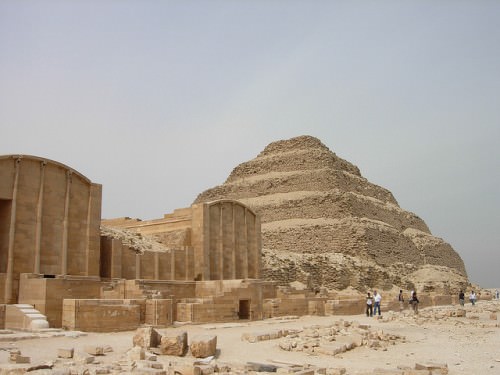
Step Pyramid Complex of Saqqara
The pyramid complex was designed to be stunning and inspire awe. When completed, the Step Pyramid rose 204 feet (62 meters) high and was the tallest structure of its time. The surrounding complex included a temple, courtyards, shrines, and living quarters for the priests covering an area of 40 acres (16 hectares) and surrounded by a wall 30 feet (10.5 meters) high.Van de Mieroop writes:
Imhotep reproduced in stone what had been previously built of other materials. The facade of the enclosure wall had the same niches as the tombs of mud brick, the columns resembled bundles of reed and papyrus, and stone cyliners at the lintels of doorways represented rolled-up reed screens. Much experimentation was involved, which is especially clear in the construction of the pyramid in the center of the complex. It had several plans with mastaba forms before it became the first Step Pyramid in history, piling six mastaba-like levels on top of one another...The weight of the enormous mass was a challenge to the builders, who placed the stones at an inward incline in order to prevent the monument breaking up (56).
The actual chambers of the tomb were dug beneath the base as a maze of tunnels with rooms off the corridors to discourage robbers and protect the body and grave goods of the king. Djoser's burial chamber was carved of granite and, to reach it, one had to navigate the corridors which were filled with thousands of stone vessels inscribed with the names of earlier kings. The other chambers in the subterranean complex were for ceremonial purposes; but not for the living, only for the soul of the pharaoh.
HOME OF THE SOUL & ENDURING MONUMENT
The soul was thought to consist of nine aspects and one of them, the ba (the bird-shaped image often found on tomb engravings), was able to fly from earth to the heavens at will. It required some recognizable landmark on earth, however, and this would have been the pyramid. Once the ba, high above, saw the home of its owner, it could swoop down, enter, and visit the earthly plane again. The importance of names and images of pharaohs comes into play here in that the soul needed to be able to recognize its former home (physical body) on earth in order to be at rest in the afterlife. The statue of Djoser, erected at the complex, is the oldest known life-sized Egyptian statuary extant and would have been created for this purpose as well as to remind the living of the legacy of the great king.
Unfortunately, all of the precautions and intricate design of the underground complex did not prevent ancient robbers from finding a way in. Djoser's grave goods, and even his mummy, were stolen at some point in the past and all archaeologists found of the king was parts of his mummified foot and a few valuables overlooked by the thieves. His Step Pyramid and the surrounding buildings of the complex still remain, however, as testimony to the great king and hero of his people.
The pyramids, like any great works of art, continue to fascinate because they leave themselves open to interpretation by people of any culture and any time period. These interpretations, as with any painting or piece of literature, need to be based on the 'text' itself and, in this case, that text is the stone monuments themselves and the inscriptions and symbols found associated with them. However people have decided to interpret the pyramids in recent centuries, they were originally constructed as a home for the soul of the king and a monument to his life and reign; the Step Pyramid is no exception.Whatever great deeds Djoser accomplished, and they were likely many, have been forgotten over time but not his final home.The Step Pyramid at Saqqara reminds people thousands of years after Djoser's reign that this king once lived and is worthy of remembrance; and that is precisely the reason it was built.
Pizarro & the Fall of the Inca Empire › Who Was
Ancient Civilizations
In 1533 CE the Inca Empire was the largest in the world. It extended across western South America from Quito in the north to Santiago in the south. However, the lack of integration of conquered peoples into that empire, combined with a civil war to claim the Inca throne and a devastating epidemic of European-brought diseases, meant that the Incas were ripe for the taking.Francisco Pizarro arrived in Peru with an astonishingly small force of men whose only interest was treasure. With superior weapons and tactics, and valuable assistance from locals keen to rebel, the Spanish swept away the Incas in little more than a generation. The arrival of the visitors to the New World and consequent collapse of the Inca Empire was the greatest humanitarian disaster to ever befall the Americas.
THE INCA EMPIRE
The Incas themselves called their empire Tawantinsuyo (or Tahuantinsuyu) meaning 'Land of the Four Quarters' or 'The Four Parts Together'. Cuzco, the capital, was considered the navel of the world, and radiating out were highways and sacred sighting lines ( ceques ) to each quarter: Chinchaysuyu (north), Antisuyu (east), Collasuyu (south), and Cuntisuyu (west).Spreading across ancient Ecuador, Peru, northern Chile, Bolivia, upland Argentina, and southern Colombia and stretching 5,500 km (3,400 miles) north to south, a mere 40,000 Incas governed a huge territory with some 10 million subjects speaking over 30 different languages.
The Incas believed they had a divine right to rule over conquered peoples as in their mythology they were brought into existence at Tiwanaku (Tiahuanaco) by the sun god Inti. As a consequence, they regarded themselves as the chosen few, the 'Children of the Sun', and the Inca ruler was Inti's representative and embodiment on earth. In practical terms, this meant that all speakers of the Inca language Quechua (or Runasimi) were given privileged status, and this noble class then dominated all the important political, religious, and administrative roles within the empire.
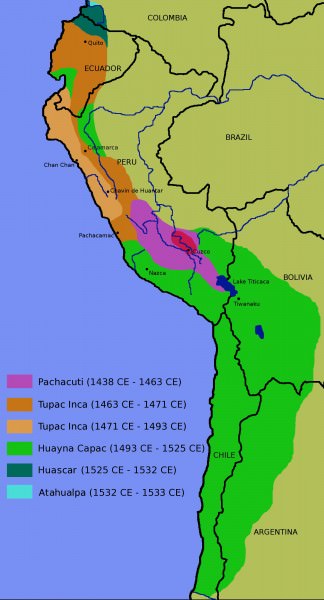
Map of the inca Empire
The rise of the Inca Empire had been spectacularly quick. Although Cuzco had become a significant centre some time at the beginning of the Late Intermediate Period (1000-1400 CE), the process of regional unification only began from the late 14th century CE and significant conquest in the 15th century CE. The Empire was still young when it was to meet its greatest challenge.
PIZARRO & THE CONQUISTADORES
Francisco Pizarro and his partner Diego de Almagro were both in their mid-50s, from humble backgrounds, and neither had won any renown in their native Spain. Adventurers and treasure-seekers, they led a small group of Spanish adventurers eager to find the golden treasures their compatriots had found in the Aztec world of Mexico a decade earlier. Sailing down the Pacific coast from Panama in two small caravel merchant ships, they searched on in Colombia and the Ecuadorian coast but could not find the gold they so desperately sought. This was Pizarro's third such expedition, and it seemed his very last chance for fame and glory.
Then, in 1528 CE, one Bartolomé Ruiz (the expedition's pilot) captured a raft off the coast which was full of treasure. There might, after all, be something worth exploring deeper in South America. Pizarro used the discovery as a means to secure the right from the Spanish king Charles V to be governor of any new territory discovered with the Crown getting its usual one-fifth of any treasure found. With a force of 168 men, which included 138 veterans, 27 cavalry horses, artillery, and one friar, a Father Valverde, Pizarro headed for the Andes.

Francisco Pizarro
In 1531 CE, making slow and careful progress, he reached and conquered Coaque on the Ecuadorian coast and waited for reinforcements. These arrived the following year and swelled the Spanish force to 260 men of which 62 were cavalry. The force moved on down the coast to Tumbes, pillaging as they went and putting the natives to the sword. Moving on again they began to see the tell-tale signs of a prosperous civilization – storehouses and well-built roads. They formed a new settlement at San Miguel (modern Piura), and by the end of the year 1532 CE Pizarro was ready to make first contact with the rulers of what seemed a huge and wealthy empire.
TROUBLE IN THE EMPIRE
When the foreign invaders arrived in Peru the Incas were already beset by some serious internal problems. As we have seen, their massive empire was a politically fragile and loose integration of conquered states whose subservience came from Inca military dominance and the taking of hostages - both of important persons and important religious artefacts - to ensure a continued, if uneasy, compliance to Cuzco's rule. Unpopular taxes were extracted in the form of goods or service (military and general labour), and many communities were forcibly resettled to other parts of the empire or had to welcome new communities of people more loyal to their overlords.
The Incas also imposed their religion on conquered peoples, even if they allowed the continued worship of some gods provided they were given a lesser status to Inti. The Incas even imposed their own art across the empire as a way to visually impress exactly who was the ruling class. There were some benefits to Inca rule – a more regulated food supply, better roads and communications, the possibility of Inca military protection, and occasional state-sponsored feasts. All in all, though, the lot of a conquered area was such that, in many cases, when a rival power threatened Inca rule, loyalty to preserve the empire was somewhat lacking. Some areas, especially in the northern territories were constantly in rebellion, and an ongoing war in Ecuador necessitated the establishment of a second Inca capital at Quito.
Perhaps more significantly than this unrest, when Pizarro arrived on the scene the Incas were fighting amongst themselves.On the death of the Inca ruler Wayna Qhapaq in 1528 CE, two of his sons, Waskar and Atahualpa, battled in a damaging six-year civil war for control of their father's empire. Atahualpa finally won but the empire was still beset by factions yet to be fully reconciled to his victory.
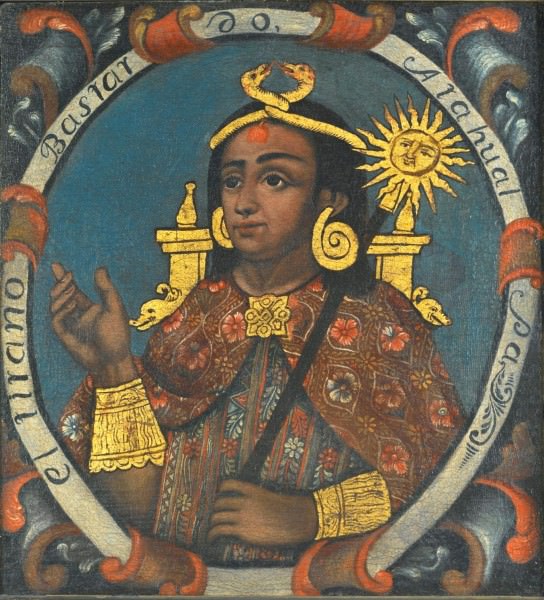
Atahualpa
Finally, if all those factors were not enough to give the Spanish a serious advantage, the Incas were at that time hit by an epidemic of European diseases, such as smallpox, which had spread from central America even faster than the European invaders themselves. Such a disease killed Wayna Qhapaq in 1528 CE and in some places a staggering 65-90% of the population would die from this invisible enemy.
PIZARRO MEETS ATAHUALPA
On Friday, 15th of November, 1532 CE, the Spaniards approached the Inca town of Cajamarca in the highlands of Peru.Pizarro sent word that he wished to meet the Inca king, there enjoying the local springs and basking in his recent victory over Waskar. Atahualpa agreed to finally meet the much-rumoured bearded white men who were known to have been fighting their way from the coast for some time. Confidently surrounded by his 80,000 strong army Atahualpa seems not to have seen any threat from such a small enemy force, and he made Pizarro wait until the next day.
The first formal meeting between Pizarro and Atahualpa involved a few speeches, a drink together while they watched some Spanish horsemanship, and not much else. Both sides went away planning to capture or kill the other party at the first available opportunity. The very next day Pizarro, using the conveniently labyrinth -like architecture of the Inca town to his advantage, set his men in ambush to await Atahualpa's arrival in the main square. When the royal troop arrived, Pizarro fired his small canons, and then his men, wearing armour, attacked on horseback. In the ensuing battle, where firearms were mismatched against spears, arrows, slings, and clubs, 7,000 Incas were killed against zero Spanish losses. Atahualpa was hit a blow on the head and captured alive.
ATAHUALPA'S RANSOM & DEATH
Either held for ransom by Pizarro or even offering a ransom himself, Atahualpa's safe return to his people was promised if a room measuring 6.2 x 4.8 metres were filled with all the treasures the Incas could provide up to a height of 2.5 m. This was done, and the chamber was piled high with gold objects from jewellery to idols. The room was then filled twice again with silver objects. The whole task took eight months, and the value today of the accumulated treasures would have been well over $50 million. Meanwhile, Atahualpa continued to run his empire from captivity, and Pizarro sent exploratory expeditions to Cuzco and Pachacamac while he awaited reinforcements from Panama, enticed by sending a quantity of gold to hint at the wealth on offer. Then, having got his ransom, Pizarro summarily tried and executed Atahualpa anyway, on the 26th of July, 1533 CE. The Inca king was originally sentenced to death by burning at the stake, but after the monarch agreed to be baptised, this was commuted to death by strangulation.
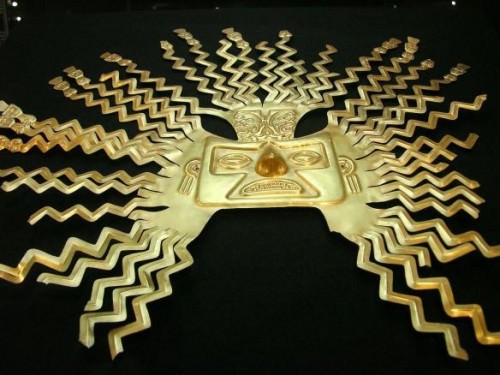
Inca Gold Sun Mask
Some of Pizarro's men thought this was the worst possible response, and Pizarro received criticism from the Spanish king for treating a foreign sovereign so shabbily, but the wily Spanish leader had seen just how subservient the Incas were to their king, even when he was held captive by the enemy. As a living god, Pizarro perhaps knew that only the king's death could bring about the total defeat of the Incas. Indeed, even in death, the Inca king exerted an influence over his people for the severed head of Atahualpa gave birth to the enduring Inkarri legend. For the Incas believed that one day the head would grow a new body and their ruler would return, defeat the Spanish, and restore the natural order of things. Crucially, the period of Atahualpa's captivity had shown the Spanish that there were deep factions in the Inca Empire and these could be exploited to their own advantage.
THE FALL OF CUZCO
Having cut off the snake's head, the Spanish then set about conquering Cuzco with its vast golden treasures which were reported by Hernando Pizarro following his reconnaissance expedition there. After that, they could deal with the rest of the empire. The first battle was with troops loyal to Atahualpa near Hatun Xauxa, but the Spaniards were helped by the local population delighted to see the back of the Incas. The Spaniards were given supplies from the local Inca storehouses, and Pizarro established his new capital there. Local assistance and the plundering of the Inca storehouses would become a familiar pattern which aided Pizarro for the remainder of his conquest.
The invaders next defeated an army in retreat at Vilcaswaman but did not have everything their own way and even suffered a military defeat when an advance force was attacked by surprise on their way to Cuzco. The next day the Old World visitors resumed their unstoppable march, though, and swept all before them. A brief resistance at Cuzco was overcome, and the cityfell into Pizarro's hands with a whimper on 15th of November, 1533 CE. The treasures of the city and the golden wonders of the Coricancha temple were ruthlessly stripped and melted down.
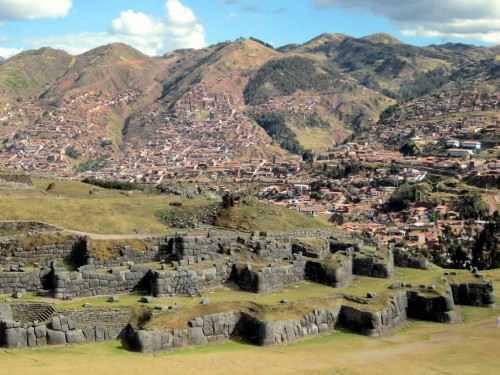
Sacsahuaman
Pizarro's first attempt to install a puppet ruler - Thupa Wallpa, the younger brother of Waskar - failed to restore any sort of political order, and he soon died of illness. A second puppet ruler was installed – Manqo Inka, another son of Wayna Qhapaq.While he ensured the state did not collapse from within, Pizarro and his men left to pacify the rest of the empire and see what other treasures they could find.
CONQUERING THE EMPIRE
The Spanish were severely tested in the northern territories, where armies led by Ruminawi and Quizquiz held out, but these too capitulated from internal strife and their leaders were killed. The Europeans' relentless conquest could not be answered. In this, they were greatly helped by the Inca mode of warfare which was highly ritualised. Such tactics as deceit, ambush, and subterfuge were unknown to them in warfare, as were changing tactics mid-battle and seizing opportunities of weakness in the enemy as they arose. In addition, Inca warriors were highly dependent on their officers, and if these conspicuous individuals fell in battle, a whole army could quickly collapse in panicked retreat. These factors and the superior weaponry of the Europeans meant the Incas had very little chance of defending a huge empire already difficult to manage. The Incas did quickly learn to fight back and deal with cavalry, for example by flooding areas under attack or fighting on rough terrain, but their spears, slings, and clubs could not match bullets, crossbows, swords, and steel armour. The Spaniards also had nearly half the population of the old empire fighting for them as old rivalries and factions re-emerged.
The Spanish soon found out that the vast geographical spread of their new empire and its inherent difficulties in communication and control (even if their predecessors had built an excellent road system) meant that they faced the same management problems as the Incas. Rebellions and defections spread all over, and even Manqo Inka rebelled and formed his own army to try and win real power for himself. Cuzco and the new Spanish stronghold of Cuidad de Los Reyes (Lima) were besieged by two huge Inca armies, but the Spaniards held out until the attackers had to retreat. The Inca armies were largely composed of farmers, and they could not abandon their harvest without starving their communities. The siege was raised again the next year, but once more the Spanish resisted, and when they killed the army leaders in a deliberately targeted attack, resistance to the new order ebbed away. Manqo Inka was forced to flee south where he set up an Inca enclave at Vilcabamba. He and his successors would resist for another four decades. Finally, in 1572 CE, a Spanish force led by Viceroy Toledo captured the Inca king Thupa Amaru, took him back to Cuzco, and executed him. The last Inca ruler was gone and with him any hope of restoring their once great empire.

Inca Road Rest Station
CONCLUSION
Atahualpa, following victory in the war with his brother, had killed historians and destroyed the Inca quipu records in what was intended to be a total renewal, what the Incas called a pachakuti or 'turning over of time and space', an epoch-changing event which the Incas believed periodically occurred through the ages. How ironic then, that Atahualpa was to suffer a pachakutihimself and the new rulers would similarly loot, burn, and destroy every vestige of Andean culture they could find. The arrival of the Old World into the New turned it upside down. Nothing would ever be the same again.
The Spanish, after decades of their own internal problems, which included the murder of Pizarro, eventually established a stable colonial government in 1554 CE. For the Andean people, their way of life, which had stretched back millennia despite the Inca interruption, would be challenged again by the new epoch. These were the lucky ones, though, as by 1570 CE 50% of the pre-Columbian Andean population had been wiped out. For those ordinary people who survived the ravages of war and disease, there was to be no respite from a rapacious overlord once again eager to steal their wealth and impose on them a foreign religion.
LICENSE
Article based on information obtained from these sources:with permission from the Website Ancient History Encyclopedia
Content is available under License Creative Commons: Attribution-NonCommercial-ShareAlike 3.0 Unported. CC-BY-NC-SA License